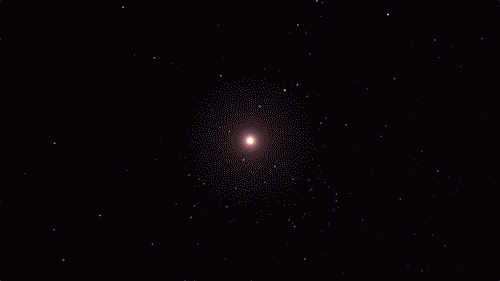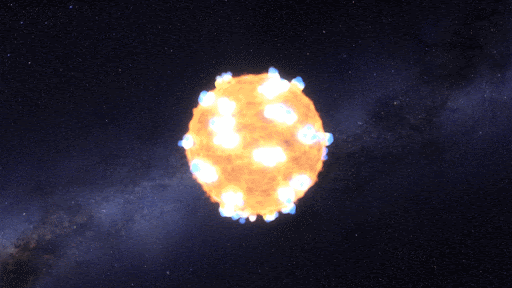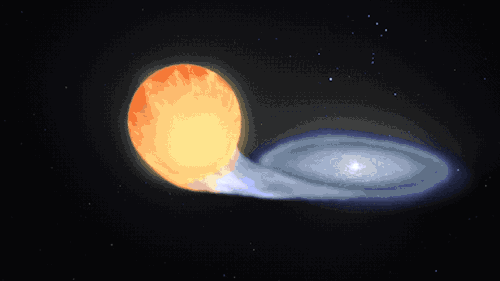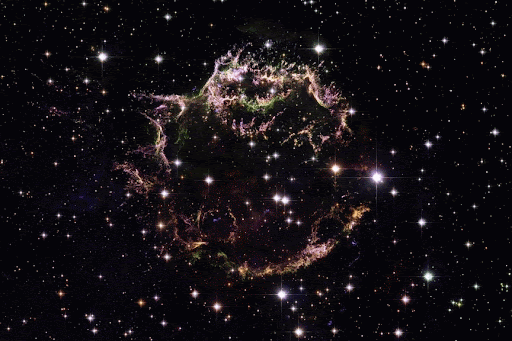You Are Made Of Stardust
You Are Made of Stardust
Though the billions of people on Earth may come from different areas, we share a common heritage: we are all made of stardust! From the carbon in our DNA to the calcium in our bones, nearly all of the elements in our bodies were forged in the fiery hearts and death throes of stars.

The building blocks for humans, and even our planet, wouldn’t exist if it weren’t for stars. If we could rewind the universe back almost to the very beginning, we would just see a sea of hydrogen, helium, and a tiny bit of lithium.
The first generation of stars formed from this material. There’s so much heat and pressure in a star’s core that they can fuse atoms together, forming new elements. Our DNA is made up of carbon, hydrogen, oxygen, nitrogen, and phosphorus. All those elements (except hydrogen, which has existed since shortly after the big bang) are made by stars and released into the cosmos when the stars die.

Each star comes with a limited fuel supply. When a medium-mass star runs out of fuel, it will swell up and shrug off its outer layers. Only a small, hot core called a white dwarf is left behind. The star’s cast-off debris includes elements like carbon and nitrogen. It expands out into the cosmos, possibly destined to be recycled into later generations of stars and planets. New life may be born from the ashes of stars.

Massive stars are doomed to a more violent fate. For most of their lives, stars are balanced between the outward pressure created by nuclear fusion and the inward pull of gravity. When a massive star runs out of fuel and its nuclear processes die down, it completely throws the star out of balance. The result? An explosion!
Supernova explosions create such intense conditions that even more elements can form. The oxygen we breathe and essential minerals like magnesium and potassium are flung into space by these supernovas.

Supernovas can also occur another way in binary, or double-star, systems. When a white dwarf steals material from its companion, it can throw everything off balance too and lead to another kind of cataclysmic supernova. Our Nancy Grace Roman Space Telescope will study these stellar explosions to figure out what’s speeding up the universe’s expansion.
This kind of explosion creates calcium – the mineral we need most in our bodies – and trace minerals that we only need a little of, like zinc and manganese. It also produces iron, which is found in our blood and also makes up the bulk of our planet’s mass!

A supernova will either leave behind a black hole or a neutron star – the superdense core of an exploded star. When two neutron stars collide, it showers the cosmos in elements like silver, gold, iodine, uranium, and plutonium.

Some elements only come from stars indirectly. Cosmic rays are nuclei (the central parts of atoms) that have been boosted to high speed by the most energetic events in the universe. When they collide with atoms, the impact can break them apart, forming simpler elements. That’s how we get boron and beryllium – from breaking star-made atoms into smaller ones.
Half a dozen other elements are created by radioactive decay. Some elements are radioactive, which means their nuclei are unstable. They naturally break down to form simpler elements by emitting radiation and particles. That’s how we get elements like radium. The rest are made by humans in labs by slamming atoms of lighter elements together at super high speeds to form heavier ones. We can fuse together elements made by stars to create exotic, short-lived elements like seaborgium and einsteinium.

From some of the most cataclysmic events in the cosmos comes all of the beauty we see here on Earth. Life, and even our planet, wouldn’t have formed without them! But we still have lots of questions about these stellar factories.
In 2006, our Stardust spacecraft returned to Earth containing tiny particles of interstellar dust that originated in distant stars, light-years away – the first star dust to ever be collected from space and returned for study. You can help us identify and study the composition of these tiny, elusive particles through our Stardust@Home Citizen Science project.
Our upcoming Roman Space Telescope will help us learn more about how elements were created and distributed throughout galaxies, all while exploring many other cosmic questions. Learn more about the exciting science this mission will investigate on Twitter and Facebook.
Make sure to follow us on Tumblr for your regular dose of space!
More Posts from Epic-flight and Others
The Lives, Times, and Deaths of Stars
Who among us doesn’t covertly read tabloid headlines when we pass them by? But if you’re really looking for a dramatic story, you might want to redirect your attention from Hollywood’s stars to the real thing. From birth to death, these burning spheres of gas experience some of the most extreme conditions our cosmos has to offer.

All stars are born in clouds of dust and gas like the Pillars of Creation in the Eagle Nebula pictured below. In these stellar nurseries, clumps of gas form, pulling in more and more mass as time passes. As they grow, these clumps start to spin and heat up. Once they get heavy and hot enough (like, 27 million degrees Fahrenheit or 15 million degrees Celsius), nuclear fusion starts in their cores. This process occurs when protons, the nuclei of hydrogen atoms, squish together to form helium nuclei. This releases a lot of energy, which heats the star and pushes against the force of its gravity. A star is born.

Credit: NASA, ESA and the Hubble Heritage Team (STScI/AURA)
From then on, stars’ life cycles depend on how much mass they have. Scientists typically divide them into two broad categories: low-mass and high-mass stars. (Technically, there’s an intermediate-mass category, but we’ll stick with these two to keep it straightforward!)
Low-mass stars

A low-mass star has a mass eight times the Sun’s or less and can burn steadily for billions of years. As it reaches the end of its life, its core runs out of hydrogen to convert into helium. Because the energy produced by fusion is the only force fighting gravity’s tendency to pull matter together, the core starts to collapse. But squeezing the core also increases its temperature and pressure, so much so that its helium starts to fuse into carbon, which also releases energy. The core rebounds a little, but the star’s atmosphere expands a lot, eventually turning into a red giant star and destroying any nearby planets. (Don’t worry, though, this is several billion years away for our Sun!)

Red giants become unstable and begin pulsating, periodically inflating and ejecting some of their atmospheres. Eventually, all of the star’s outer layers blow away, creating an expanding cloud of dust and gas misleadingly called a planetary nebula. (There are no planets involved.)

Credit: NASA, ESA, and the Hubble Heritage Team (STScI/AURA)
All that’s left of the star is its core, now called a white dwarf, a roughly Earth-sized stellar cinder that gradually cools over billions of years. If you could scoop up a teaspoon of its material, it would weigh more than a pickup truck. (Scientists recently found a potential planet closely orbiting a white dwarf. It somehow managed to survive the star’s chaotic, destructive history!)

High-mass stars
A high-mass star has a mass eight times the Sun’s or more and may only live for millions of years. (Rigel, a blue supergiant in the constellation Orion, pictured below, is 18 times the Sun’s mass.)

Credit: Rogelio Bernal Andreo
A high-mass star starts out doing the same things as a low-mass star, but it doesn’t stop at fusing helium into carbon. When the core runs out of helium, it shrinks, heats up, and starts converting its carbon into neon, which releases energy. Later, the core fuses the neon it produced into oxygen. Then, as the neon runs out, the core converts oxygen into silicon. Finally, this silicon fuses into iron. These processes produce energy that keeps the core from collapsing, but each new fuel buys it less and less time. By the point silicon fuses into iron, the star runs out of fuel in a matter of days. The next step would be fusing iron into some heavier element, but doing requires energy instead of releasing it.
The star’s iron core collapses until forces between the nuclei push the brakes, and then it rebounds back to its original size. This change creates a shock wave that travels through the star’s outer layers. The result is a huge explosion called a supernova.

What’s left behind depends on the star’s initial mass. Remember, a high-mass star is anything with a mass more than eight times the Sun’s — which is a huge range! A star on the lower end of this spectrum leaves behind a city-size, superdense neutron star. (Some of these weird objects can spin faster than blender blades and have powerful magnetic fields. A teaspoon of their material would weigh as much as a mountain.)

At even higher masses, the star’s core turns into a black hole, one of the most bizarre cosmic objects out there. Black holes have such strong gravity that light can’t escape them. If you tried to get a teaspoon of material to weigh, you wouldn’t get it back once it crossed the event horizon — unless it could travel faster than the speed of light, and we don’t know of anything that can! (We’re a long way from visiting a black hole, but if you ever find yourself near one, there are some important safety considerations you should keep in mind.)

The explosion also leaves behind a cloud of debris called a supernova remnant. These and planetary nebulae from low-mass stars are the sources of many of the elements we find on Earth. Their dust and gas will one day become a part of other stars, starting the whole process over again.
That’s a very brief summary of the lives, times, and deaths of stars. (Remember, there’s that whole intermediate-mass category we glossed over!) To keep up with the most recent stellar news, follow NASA Universe on Twitter and Facebook.
Make sure to follow us on Tumblr for your regular dose of space: http://nasa.tumblr.com.

Orbiting - 210216

Another beautiful space painting from my friend Steve R Dodd. ‘The Beacon’. Originally displayed in NASA’s 25th anniversary art show, Cleveland Museum of Natural History (1980s)

Arrival at an Exoplanet, 1983, by David A. Hardy, painted in gouache originally for the cover of Analog Science Fiction/Fact, June 1983.”
(AstroArt)

‘antipode’

Another oldie from my draft folder. I’d like to do a mass deletion of 99% of my unposted drafts.

All the Little Moments.
Twitter / Instagram / Gumroad / Patreon
KnownOrigin / SuperRare / OBJKT / Zedge

Flash Forward.
Twitter / Instagram / Gumroad / Patreon
KnownOrigin / SuperRare / Zedge
-
 bobby76love reblogged this · 3 weeks ago
bobby76love reblogged this · 3 weeks ago -
 kayayayayayayay liked this · 1 month ago
kayayayayayayay liked this · 1 month ago -
 yeehawdimus liked this · 1 month ago
yeehawdimus liked this · 1 month ago -
 bobby76love reblogged this · 3 months ago
bobby76love reblogged this · 3 months ago -
 davinamikaelsonalwaysandforever liked this · 4 months ago
davinamikaelsonalwaysandforever liked this · 4 months ago -
 amity297 liked this · 4 months ago
amity297 liked this · 4 months ago -
 valiantsuitfury liked this · 4 months ago
valiantsuitfury liked this · 4 months ago -
 insertanepicusername liked this · 4 months ago
insertanepicusername liked this · 4 months ago -
 cosmicjester6 liked this · 4 months ago
cosmicjester6 liked this · 4 months ago -
 happybatshoeapricot liked this · 5 months ago
happybatshoeapricot liked this · 5 months ago -
 venusianguy reblogged this · 6 months ago
venusianguy reblogged this · 6 months ago -
 faithfuldissident reblogged this · 6 months ago
faithfuldissident reblogged this · 6 months ago -
 glutiamentous liked this · 6 months ago
glutiamentous liked this · 6 months ago -
 emaadsidiki liked this · 7 months ago
emaadsidiki liked this · 7 months ago -
 instantpandadefendor liked this · 7 months ago
instantpandadefendor liked this · 7 months ago -
 emstargazer reblogged this · 8 months ago
emstargazer reblogged this · 8 months ago -
 emstargazer liked this · 8 months ago
emstargazer liked this · 8 months ago -
 superjinaaaa reblogged this · 8 months ago
superjinaaaa reblogged this · 8 months ago -
 superjinaaaa liked this · 8 months ago
superjinaaaa liked this · 8 months ago -
 what-the-hell-is-going-on-here reblogged this · 8 months ago
what-the-hell-is-going-on-here reblogged this · 8 months ago -
 dobyina liked this · 10 months ago
dobyina liked this · 10 months ago -
 ruththe-reckless reblogged this · 10 months ago
ruththe-reckless reblogged this · 10 months ago -
 pleasantinfluencerrebel reblogged this · 10 months ago
pleasantinfluencerrebel reblogged this · 10 months ago -
 beyourselfchulanmaria reblogged this · 10 months ago
beyourselfchulanmaria reblogged this · 10 months ago -
 panfriedgarlicbread reblogged this · 11 months ago
panfriedgarlicbread reblogged this · 11 months ago -
 4thethingsilike reblogged this · 11 months ago
4thethingsilike reblogged this · 11 months ago -
 4thethingsilike reblogged this · 11 months ago
4thethingsilike reblogged this · 11 months ago -
 not-shitposting-iswear liked this · 11 months ago
not-shitposting-iswear liked this · 11 months ago -
 silverprimal liked this · 11 months ago
silverprimal liked this · 11 months ago -
 looookingup reblogged this · 1 year ago
looookingup reblogged this · 1 year ago -
 misskohane liked this · 1 year ago
misskohane liked this · 1 year ago -
 bboogeyman reblogged this · 1 year ago
bboogeyman reblogged this · 1 year ago -
 thealicedoll liked this · 1 year ago
thealicedoll liked this · 1 year ago -
 ghostwriterxp liked this · 1 year ago
ghostwriterxp liked this · 1 year ago -
 guthearse reblogged this · 1 year ago
guthearse reblogged this · 1 year ago -
 lululumune liked this · 1 year ago
lululumune liked this · 1 year ago -
 blog-dylan liked this · 1 year ago
blog-dylan liked this · 1 year ago -
 happymeishappylife reblogged this · 1 year ago
happymeishappylife reblogged this · 1 year ago -
 whitestnoise reblogged this · 1 year ago
whitestnoise reblogged this · 1 year ago -
 rituals-in-starlight liked this · 1 year ago
rituals-in-starlight liked this · 1 year ago -
 irllka liked this · 1 year ago
irllka liked this · 1 year ago

